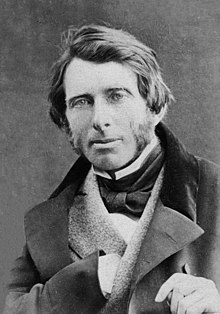Ruskinian
| John Ruskin | |
|---|---|

John Ruskin in 1863
|
|
| Born |
8 February 1819 54 Hunter Street, Brunswick Square, London, England, United Kingdom |
| Died | 20 January 1900 (aged 80) Brantwood, Coniston, Lancashire, England, United Kingdom |
| Occupation | Writer, art critic, draughtsman, watercolourist, social thinker |
| Citizenship | English |
| Alma mater |
Christ Church, Oxford King's College, London |
| Period | Victorian era |
| Notable works | Modern Painters 5 vols. (1843–60), The Seven Lamps of Architecture (1849), The Stones of Venice 3 vols. (1851–53), Unto This Last (1860, 1862), Fors Clavigera (1871–84), Praeterita 3 vols. (1885–89). |
| Spouse | Euphemia Chalmers Gray (1848–1854) (marriage annulled) |
|
|
|
| Signature |  |
John Ruskin (8 February 1819 – 20 January 1900) was the leading English art critic of the Victorian era, as well as an art patron, draughtsman, watercolourist, a prominent social thinker and philanthropist. He wrote on subjects as varied as geology, architecture, myth, ornithology, literature, education, botany and political economy. His writing styles and literary forms were equally varied. Ruskin also penned essays and treatises, poetry and lectures, travel guides and manuals, letters and even a fairy tale. The elaborate style that characterised his earliest writing on art was later superseded by a preference for plainer language designed to communicate his ideas more effectively. In all of his writing, he emphasised the connections between nature, art and society. He also made detailed sketches and paintings of rocks, plants, birds, landscapes, and architectural structures and ornamentation.
He was hugely influential in the latter half of the 19th century, and up to the First World War. After a period of relative decline, his reputation has steadily improved since the 1960s with the publication of numerous academic studies of his work. Today, his ideas and concerns are widely recognised as having anticipated interest in environmentalism, sustainability and craft.
Ruskin first came to widespread attention with the first volume of Modern Painters (1843), an extended essay in defence of the work of J. M. W. Turner in which he argued that the principal role of the artist is "truth to nature". From the 1850s he championed the Pre-Raphaelites who were influenced by his ideas. His work increasingly focused on social and political issues. Unto This Last (1860, 1862) marked the shift in emphasis. In 1869, Ruskin became the first Slade Professor of Fine Art at the University of Oxford, where he established the Ruskin School of Drawing. In 1871, he began his monthly "letters to the workmen and labourers of Great Britain", published under the title Fors Clavigera (1871–1884). In the course of this complex and deeply personal work, he developed the principles underlying his ideal society. As a result, he founded the Guild of St George, an organisation that endures today.
...
Wikipedia
